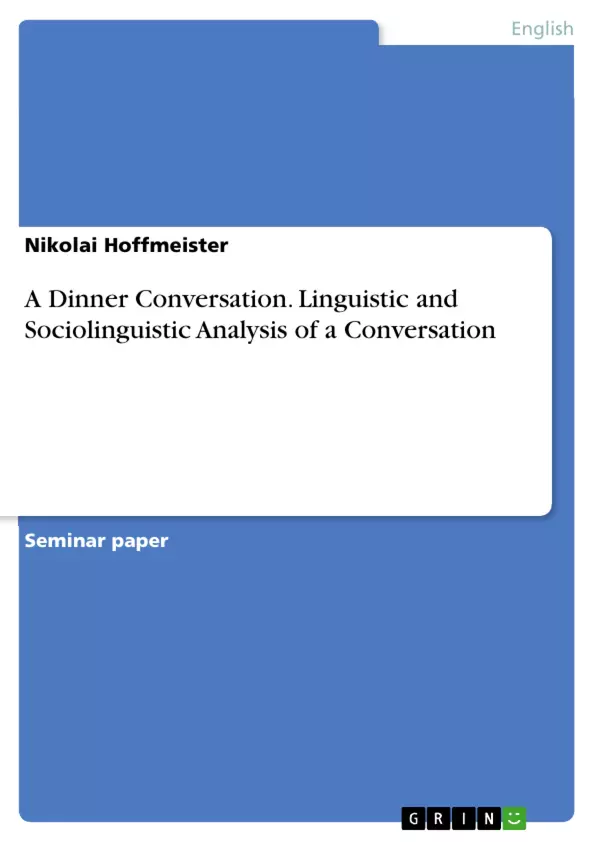In this paper, a transcript has been taken out of a dinner conversation found on the video platform ‘youtube’. The objectives are to analyse the data linguistically with methods that were introduced by conversational analysis, to interpret findings from a pragmatic point of view, thus employing an approach that is close to interactional sociolinguistics. This paper is divided into three parts: The first one is a theoretical approach where several topics will be explained. The second one is a presentation of an authentic dinner conversation of three people which is transcribed. The last part is the text analysis. It includes proving the different linguistic topics by means of the theoretical approach. The defined notions of conversational analysis will be applied, while the pragmatic point of view will be taken into consideration for the interpretation. Moreover, each of the transcripts will be analysed individually and the discourses that they feature will be examined.
Inhaltsverzeichnis (Table of Contents)
- Introduction
- Theory of Conversational Analysis
- Definition of Conversation
- Turn-Taking
- Adjacency Pairs
- Preference Organization
- Repair
- Problems in Conversations
- Transcription of "Random Dinner Conversations” (Jefferson Transcription)
- Analysis of the Dinner Conversation
- Conclusion
Zielsetzung und Themenschwerpunkte (Objectives and Key Themes)
This paper analyzes a dinner conversation recorded on YouTube using methods of conversational analysis. The analysis aims to interpret the data linguistically from a pragmatic perspective, drawing upon interactional sociolinguistics. The paper is divided into three parts: a theoretical explanation of conversational analysis, a transcription of the conversation, and a text analysis that applies the theoretical framework to interpret the conversation.
- Definition of Conversation
- Turn-Taking System
- Adjacency Pairs
- Preference Organization
- Repair and Problems in Conversations
Zusammenfassung der Kapitel (Chapter Summaries)
- Introduction: This section outlines the objectives and methodology of the paper, highlighting the use of conversational analysis and interactional sociolinguistics to analyze a dinner conversation from YouTube.
- Theory of Conversational Analysis: This section defines conversation from a linguistic perspective, contrasting it with everyday usage. The chapter introduces turn-taking as a fundamental aspect of conversation, discussing its rules and mechanisms. It also explores the concept of adjacency pairs, which are two-part exchanges in conversations.
- Transcription of "Random Dinner Conversations” (Jefferson Transcription): This chapter presents the transcript of the analyzed dinner conversation, utilizing the Jefferson Transcription system.
- Analysis of the Dinner Conversation: This section analyzes the dinner conversation, applying the theoretical framework presented in the first part. The focus is on identifying and explaining the linguistic features of the conversation.
Schlüsselwörter (Keywords)
This paper examines conversation analysis, turn-taking, adjacency pairs, pragmatic analysis, and interactional sociolinguistics. It uses a transcribed dinner conversation to illustrate and analyze these concepts.
- Quote paper
- Nikolai Hoffmeister (Author), 2020, A Dinner Conversation. Linguistic and Sociolinguistic Analysis of a Conversation, Munich, GRIN Verlag, https://www.grin.com/document/947586



